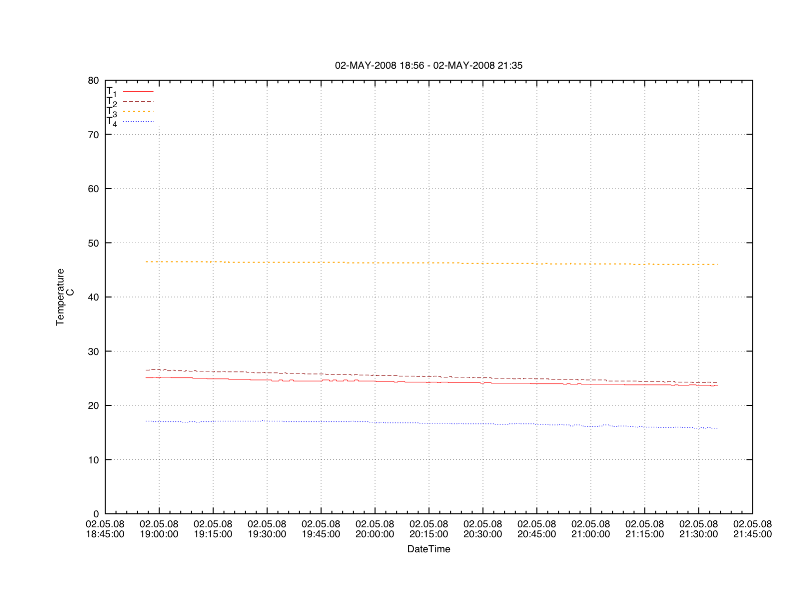The logger allows you to capture up to 16,000 samples from up to four different K-Type temperature probes. Depending on the probes, a temperature range of -200°C (-328°F) to 1370°C (2498°F) may be covered with a 0.1°C resolution.
The K204 sports a serial port and comes with a RS232 cable. No Macintosh computer has come with a RS232 port for the last ... what ... decade or so?
Fortunately for me, Conrad also sell a USB adapter for the device. Unfortunately, but predictably, only Microsoft Windows compatible software is included on the CD.
I plugged the USB adapter in and checked the device ID. It turns out that the adapter is basically a Silicon Labs CP2102 USB to UART bridge . Silicon Labs provide a number of drivers , including a Linux and a Mac OS X driver for the device. Conrad provide a brief description of the communications protocol used by the K204. That is what I call useful customer support!
After a couple of hours of work, most of which where spent figuring out the differences between the protocol description and the real protocol, I had a working application to read all data samples from the device on Mac OS X.
It is very simple to use:
1. Open a Terminal.app.
2. Type:
> k204 /dev/tty.SLAB_USBtoUART dumpfile.txtwhere
/dev/tty.SLAB_USBtoUART is the serial device created by the driver and dumpfile.txt is the file you want to create.This will create a file with content similar to this sample:
Data Set: 1
Sample start: 2008-05-02 17:56:18
Sample interval in seconds: 60
Sensor type: K-Type
Temperature unit: Celsius
Number of sample sets: 16000
Data Set CH1 CH2 CH3 CH4
2008-05-02 18:56:18 25.2 26.5 46.5 17.1
2008-05-02 18:57:18 25.1 26.5 46.5 17.1
2008-05-02 18:58:18 25.1 26.6 46.5 17.1
2008-05-02 18:59:18 25.2 26.6 46.5 17.0
2008-05-02 19:00:18 25.1 26.6 46.5 17.0
2008-05-02 19:01:18 25.2 26.5 46.5 17.0
2008-05-02 19:02:18 25.2 26.6 46.5 17.0
2008-05-02 19:03:18 25.2 26.4 46.5 17.0Note that you may have multiple data sets, depending on how and what you captured. In this case, you will have multiple
Data Set: headers.The fields are TAB ('\t') separated.
3. You can remove the header from the file using a text editor or by using the shell command
tail -n +7 dumpfile.txt >dumpfile.tsv4. Your favorite data display tool will now render the file. You can use OpenOffice/NeoOffice or Excel or whatever. I like using gnuplot :
# Plot data downloaded from K204 Thermologger
# These settings are optimized for use with the PostScript driver.
# define line styles
set style line 1 linetype 1 linecolor rgb "red" linewidth 1
set style line 2 linetype 2 linecolor rgb "dark-red" linewidth 1
set style line 3 linetype 3 linecolor rgb "orange" linewidth 2
set style line 4 linetype 4 linecolor rgb "blue" linewidth 1
set style data fsteps
set xlabel "Date\Time"
set timefmt "%Y-%m-%d %H:%M:%S" #2008-03-21 13:20:00
set yrange [ 0 : 80 ]
set xdata time
#set xrange [ "2008-03-25 15:28:19":"2008-03-26 20:52:54" ]
set ylabel "Temperature\n° C"
set format x "%d.%m.%y\n%H:%M:%S"
set key inside left top vertical Right noreverse enhanced autotitles nobox
set style data fsteps
set grid nopolar
set grid xtics nomxtics ytics nomytics noztics nomztics \
nox2tics nomx2tics noy2tics nomy2tics nocbtics nomcbtics
set grid layerdefault linetype 0 linewidth 1.000, linetype 0 linewidth 1.000
set title "02-MAY-2008 18:56 - 02-MAY-2008 21:35"
plot "dumpfile.tsv" using 1:3 title "T_{1}" linestyle 1, \
"dumpfile.tsv" using 1:4 title "T_{2}" linestyle 2, \
"dumpfile.tsv" using 1:5 title "T_{3}" linestyle 3, \
"dumpfile.tsv" using 1:6 title "T_{4}" linestyle 4Which gives you this - admittedly somewhat boring, but rather good-looking - plot:

Congratulations, you have made it this far, so here is your reward: I am releasing the sources under a BSD-style license .
The sources compile and run under Mac OS X 10.4.9 and later. I have not tried 10.5 yet, but I see no reason why there should be a problem.
Update: It works just fine under 10.5. :)
Similarly, I fully expect the program to compile and run under most BSD or Unix variants (including Linux), providing they support the tcgetattr() /tcsetattr() options used.
I am very interested in hearing from you if you deployed the program on other platforms. Drop me a line or submit a comment and, most importantly, share your modifications so that everyone can profit. Have fun!
Update 21-JAN-2009: Silicon Labs have changed the links on their website, so I changed mine. Come on guys, how long have you been at this web game?
Communication with the K204 works, device type is displayed as 304. Unfortunatelly, the data sets are always empty. Is there some special magic I need to perform to get temperatures to be dumped? "Transmitting 0 bytes in 0 data sets." the k204 says and then the program exits.
ReplyDeleteWhat version of Mac OS X are you using? In 10.4 I could just plug in the adapter and everything worked just fine. Since I upgraded to 10.5 it seems that I have to boot the machine while the adapter is plugged in to a USB port.
ReplyDeleteI believe that the error was what you describe if I did not boot with the adapter plugged in ... I will check when I get home tonight.
My tests show that in Mac OS X 10.5.6 with the v1.06 driver you have to boot with the adapter connected or you will get the “Transmitting 0 bytes in 0 data sets.” behavior.
ReplyDeleteWith the (currently) most recent v2.1 driver you can hot-plug the adapter and data will be transmitted just fine.